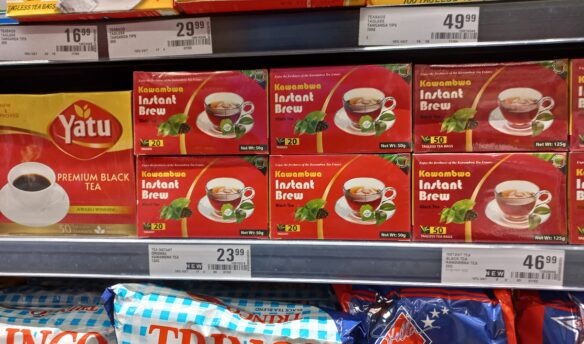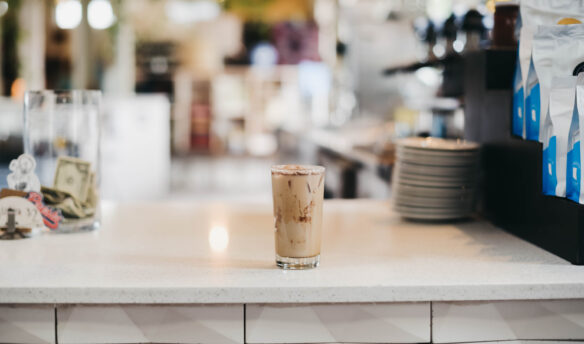When Jessie Dean brews a steaming mug of tea, she knows where each ingredient is grown. In Ginger Turmeric tea, the ginger is from A Way of Life Farm, Rayburn Farm grew the turmeric, and the lemon balm was sourced from Gentle Harmony Farm.
Dean worked with farmers in her hometown of Asheville, North Carolina, to source ingredients for local brews and spent countless hours experimenting with recipes to create farm-to-teacup blends.
Dean credits her British-born husband with her passion for brewing the perfect cup of tea.
“Tea culture is a big part of life in England,” she explains.
But the culture in her hometown of Asheville convinced Dean there was a market for her local, small-batch teas. “Asheville has a thriving craft beverage scene and a great farm-to-table scene, but it was impossible to find local tea on restaurant menus, in shops, or at the farmers market,” Dean says.
Dean launched Asheville Tea Company in 2016. The start-up partners with farmers throughout western North Carolina to source ingredients ranging from basil and spearmint to chamomile and elderflower for blends like Mountain Mint, Wild Earl, G & Tea, Lemon Yaupon, and Chamomile and Lavender. “Local teas are much more fresh and flavorful than teas sold at the store,” Dean says. The idea of creating a market for what Dean calls “the other craft brew” is catching on.
A Movement In the Making
Tea is grown and sold worldwide, but some creative entrepreneurs are making brews steeped in the local food movement. These farm-to-teacup brews offer a taste of place in each sip—and the market for local teas is growing. The Tea Association of the USA estimates an annual growth rate of 8 to 10 percent for the specialty tea market, which includes local teas.
Tirza Wibel, the founder of Winterwoods Tea Company, notes the favorability of timing. “People want to support local; we are in the right place, at the right time, with the right idea.”
Wibel started making tea from local ingredients in 2014. The feedback was so positive that Wibel rented space in a commercial kitchen and started producing small-batch blends like Harvest Apple, Homestead Peach, Pacific Coast Lavender, and Old Town Licorice, selling them at farmers’ markets around Spokane, Washington.
“Sales beat all expectations,” Wibel recalls. “I started getting more wholesale orders, and things grew from there.”
To fill orders from Washington coffee shops like Batch Bakeshop, Coeur Coffeehouse, and Atticus, Wibel needed to expand production. She launched a Kickstarter campaign in 2015, intending to raise $13,450 to build a commercial kitchen, and backers loved the concept and provided more than $30,000 in support during the thirty-day campaign.
While Wibel continued selling at local farmers’ markets, the crowdfunding campaign allowed her to expand from seven to fourteen original blends. Today, Winterwoods Tea Company teas are sold in more than 100 gift shops, coffee shops, and health food stores across the country. Despite the growth, Wibel remained committed to producing gourmet tea blends from local and organic ingredients.
“One of the biggest benefits of local tea, aside from the flavor, is that it supports local businesses and communities,” Wibel says. “You don’t get that from generic teas from far away.”
Getting from Farm to Teacup
For North American tea drinkers, local flavors have historically been hard to come by. The tea plant, Camellia sinensis, is indigenous to Asia, where most production still occurs.
According to the US League of Tea Growers, there are about sixty tea farms in the US and Canada. It takes about five years for Camellia sinensis to mature, which means farms like the Great Mississippi Tea Company, Teafarm, and Table Rock Tea Company that started growing the crop after 2012 are not harvesting enough tea to meet the demand for local teas.
All the small-batch teas from Winterwoods Tea Company are made with fair-trade organic tea leaves imported from India; Asheville Tea Company uses tea leaves from Kenya in its blends. Dean also uses yaupon, a tea-like plant native to North America that grows in abundance in North Carolina, for blends like Lemon Yaupon and Elderberry Yaupon. Both plan to source domestically as soon as Camellia sinensis is widely available in the United States.
A commitment to local ingredients led Jonathan Gardner to plant yaupon and bamboo leaf tea on his six-acre Tuscaloosa, Alabama, farm in 2016. Gardner, the owner of Tea Town Alabama, plans to use the mature crop to make local teas like Hibiscus Bliss, Spring Mint, and Lemon Ginger.
“When we started [in 2014], we were buying ingredients from local farmers,” Gardner recalls. “We want to grow as much as possible and aim to produce 80 percent of the ingredients we use in our teas.” Gardner has planted dozens of varieties of herbs; he’ll continue partnering with local producers to source fresh fruits like peaches and apples that take longer to grow.
The do-it-yourself approach to sourcing ingredients makes sense to Dean. “I’m dedicated to sourcing locally, but the biggest challenge [of using local spices, fruits, and herbs] is cost and availability,” she says. One of the first Asheville Tea Company blends, G & Tea, was so popular that Dean couldn’t source enough lime basil to keep up with demand, and it is now only offered seasonally.
The experience forced Dean to rethink her blends. She now offers six primary blends, including Elderberry Yaupon, Wild Earl, and Echinacea and Elderflower—all made with ingredients that can be reliably locally sourced in abundance—and rotating seasonal blends featuring spices, herbs, and fruits that are more scarce.
“There are an incredible number of farms around Asheville growing amazing organic herbs, and I want to work with more of them to get what I need,” Dean says. To connect with farmers who would be open to working with a start-up, Dean reached out to the local extension office and Appalachian Sustainable Agriculture Project, a nonprofit that links farmers with markets for their products.
Wibel has also prioritized developing relationships with local farmers but admits she was met with some skepticism when she started sourcing ingredients for Winterwoods Tea Company. “Their reaction was, ‘You want to use our apples in tea?'” she recalls. “Now we’re one of their unique customers, and farmers appreciate that we’re doing something different with their products.”
A Process Steeped in Trial and Error
Connecting with farmers to access local ingredients was just one step in a complex process to develop fresh loose-leaf tea blends. “You have to figure out what to do with the ingredients, how to blend multiple herbs or spices, and understand how to incorporate them to have the right influence on the flavor,” Wibel says.
Local ingredients might not work in traditional tea recipes; some ingredients, like cloves, are not grown in the United States, which forces tea-makers to decide whether to bend the “all local” rules or forgo popular brews because there are no domestic suppliers for specific ingredients.
For Dean, local ingredient availability drove the creative process. Her original ideas for tea blends were scrapped in favor of incorporating (often unusual) bounty from local farmers. “There were some things like pineapple sage flower and lime basil that I didn’t know existed before I started working with local farmers,” she explains. “I knew nothing about their flavors or how they would work with tea.”
Dean blended pineapple sage flower with yaupon and wintergreen mint for a seasonal blend called Happy Holly Days and incorporated lime basil with lime peel and juniper to create the gin and tonic–inspired G & Tea.
Although popular tea blends were created from unexpected ingredients, Dean admits that only some of her recipes turned out to be successful: countless attempts to make chocolate Earl Grey tea were disastrous.
“There was a lot of experimentation and plenty of teas that were poured down the sink,” she says.
Brewing for the Masses
A trial-and-error process can also be necessary to find venues to sell local teas.
When Gardner introduced the Tea Town mobile truck in 2014, he thought the brand would be a hit with local fans attending University of Alabama football games. But it was hard to convince fans to choose local tea over a cold beer, and the price points—which ranged from three to four dollars per cup—proved too expensive for the crowd. Sales were lackluster.
Instead of returning to the stadium, Gardner focused on farmers’ markets and art festivals in larger cities like Birmingham and Montgomery.
“We have to travel, to go where people are more aware of what goes into producing tea made from local ingredients and willing to pay for our products,” Gardner explains. “We’re not just standing behind the bar selling tea; it takes a lot more work to explain to people what we do and why it matters.”
Since introducing local teas in 2014, Tea Town has expanded from a mobile “tea truck” parked at farmers’ markets to a brick-and-mortar tea shop. The Tuscaloosa café opened in 2016. In addition to piping hot teapots steeping two signature brews, Tea Town sells single tea bags to steep in to-go cups and loose-leaf teas.
Tea Town shares space with a bakery, giving Gardner access to a commercial kitchen to experiment with new blends. As the thirst for local tea grows, so does the demand for new flavors.
Wibel launched a second Kickstarter campaign in 2016, hoping to raise $2,500 to introduce four new Pacific Northwest blends: Wildwood Cedar made with wild cedar tips, peppermint, and cinnamon bark; Bee Wrangler made from fair trade Ceylon tea infused with maple extract and organic bee pollen; Mount Hood Hops, a combination of hops, chamomile, dried pears, and vanilla; and Smoke + Juniper, a blend of black lapsang souchong tea smoked over spruce wood. The thirty-day campaign attracted 669 backers who contributed more than $25,000—ten times the original goal.
“The idea of farm-to-teacup resonated with people,” Wibel says. “Now that we’re out there, people are coming back over and over again to order. The demand keeps growing.”
Jodi Helmer is a North Carolina–based freelancer who writes about the intersection between food, farming, and business (while drinking copious amounts of Earl Grey).
This article was originally published on March 6, 2017 and has been updated to meet Fresh Cup’s current editorial standards.






















